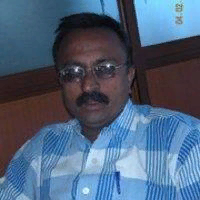
S.V Gumaste
Work place: Computer Engineering, R. H. Sapat College of Engineering, Nashik, Maharashtra, India
E-mail: svgumaste@gmail.com
Website:
Research Interests: Data Structures and Algorithms, Speech Synthesis, Speech Recognition, Image Processing, Image Manipulation, Image Compression
Biography
Dr. S.V Gumaste was born on 02 April 1968 in Karnataka, India and presently working as a Professor & Head, Computer Engineering, Computer Engineering, R. H. Sapat College of Engineering, Nashik, Maharashtra, India. He has 22.5 years of teaching experience at various institutions. He received Ph.D degree from Sant Gadge Baba Amravati University, Amravati in 2015. He obtained M.E (CSE) Degree in 2007 from Prof. Ram Meghe Institute of Technology & Research, Badnera, Amravati. (Sant Gadge Baba Amravati University, Amravati, Maharashtra) and He received BE (CSE) Degree in 1992 from BLDE College of Engineering & Technology, Bijapur. (Karnataka University, Dharwar). He is the author of 03 Books such as fundamentals of C Programming, Exel Publication, Amravati. (In August, 2005), C Programming with 150 solved programs, Exel Publication, Amravati. (In January, 2005) and Basics of C Programming: A Practical Approach, Jai Publication, Pusad. (In August, 2004). He has published more than 12 research papers in International Journals and presented 12 papers in international conferences. His main research interest includes networking, image processing and speech processing. He is the life Membership with Professional Bodies of LM-20507, Indian Society for Technical Education, New Delhi, Institutional Member (N0046703), Computer Society of India, Mumbai (2008-09) and (MH/222/1645), All India Federation of University & College Teachers’ Organisations, Hyderabad (AIFUCTO).
Author Articles
Curvilinear Tracing Approach for Extracting Kannada Word Sign Symbol from Sign Video
By Ramesh M. Kagalkar S.V Gumaste
DOI: https://doi.org/10.5815/ijigsp.2017.09.03, Pub. Date: 8 Sep. 2017
Gesture based communications are utilized as a primary method of correspondence, however, the differing qualities in the sign image portrayal limit its use to district bound. There is a tremendous assorted quality in the sign image portrayal from one nation to another, one state to another. In India, there is distinctive gesture-based communication watched for each state locale. It is henceforth exceptionally troublesome for one area individual to convey to other utilizing a signature image. This paper proposes a curvilinear tracing approach for the shape portrayal of Kannada communication via gestures acknowledgment. To build up this approach, a dataset is consequently made with all Swaragalu, Vyanjanagalu, Materials and Numbers in Kannada dialect. The arrangement of the dataset is framed by characterizing a vocabulary dataset for various sign images utilized as a part of regular interfacing. In the portrayal of gesture-based communication for acknowledgment, edge elements of hand areas are thought to be an ideal element portrayal of communication through signing. In the preparing of gesture-based communication, the agent includes assumes a critical part in arrangement execution. For the developed approach of sign language detection, where a single significant transformation is carried out, a word level detection is then performed. To represent the processing efficiency, a set of cue symbols is used for formulating a word. This word symbols are then processed to evaluate the performance for sign language detection. Word processing is carried out as a recursive process of a single cue symbol representation, where each frame data are processed for a curvilinear shape feature. The frame data are extracted based on the frame reading rate and multiple frames are processed in successive format to extract the region of interest. A system outline to process the video data and to give an optimal frame processing for sign recognition a word level process is performed.
[...] Read more.Other Articles
Subscribe to receive issue release notifications and newsletters from MECS Press journals